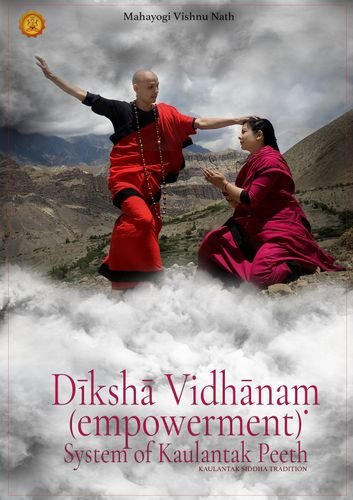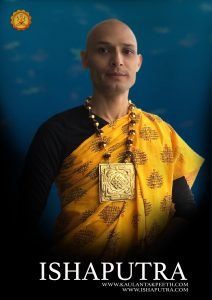Deeksha Vidhanam (The empowerment system of Kaulantak Peeth), is a book totally dedicated to deekshas and theirs uses. This book is more of a collection of different deeksha forms and their explanations. The explanations of various deekshas are presented in agama-nigama conversation style between His Holiness Kaulantak Nath and his consort Ma Padma Priya while they were travelling to Upper Mustang, Nepal along with his two Bhairavas and one of them is the compiler of this book.
This book explains deeksha and its forms. It further expands the domain of deeksha by explaining various facets of deeksha. The deeksha forms and procedures basically makes up the modus operandi of the deeksha system of Kaulantak Peeth. The deeksha system is based on the lineage of “Kaula Siddha Dharma”.
If the book is to be read thoroughly, it is believed that the reader shall have first hand experience in understanding the purpose behind different activities of Kaulantak Peeth while at the time of deeksha compartment.
TITLE
The title of the book is “Deeksha Vidhanam”. Deeksha means initiation of any spiritual activities or sadhana. Vidhanam means system therefore, the synthesis of both words would give the meaning “deeksha system”.
WRITER’S PURPOSE
The whole purpose of this book is to manifest the conversation between His Holiness Kaulantak Nath and his consort Ma Padma Priya about deekshas that happened during the Upper Mustang travel in a written form for the public. This book is also for the Kaulantak Peeth fraternity and for the future siddhas who pursue “Kaula Siddha” dharma for the perfection of their life.
DESCRIPTION
The book starts with writer’s preface which explains about his inner spiritual journey to Kaulantak Peeth. He explains about his personal experience in his life and his inner transformation that led him to take deeksha from the peeth.
The first chapter starts with the arrival of His Holiness Mahasiddha Ishaputra and his consort Ma Padma Priya to Kathmandu under the invitation of one of the most prominent personality of Nepal. His visit to Kathmandu is basically to travel Upper Mustang for unrevealed purpose.
From Jomsom, the travel to Upper Mustang is made on four-wheeler jeep. The road ahead is the rocky not pitched roads that is full of bumps. It is a hectic ride and it shall take around eight hours to reach the destination. In the midst of the ride, the conversation starts. The conversation starts from the topic of deeksha and for the whole book shall revolve around it.
His Holiness Kaulantak Nath explains the concept of deeksha and explains his consort Ma Padma Priya about the philosophy of deeksha in a very simple and precise term with example.
The second chapter is the explanation of “Sookshma Deeksha” and its importance in Kaula Siddha dharma. The sookshma deeksha is very important deeksha yet not known to the people. His Holiness basically explains how sookshma deeksha works. The writer also adds his experience dealing with sookshma diksha and how he managed to know the meaning of sooksham deeksha by missing a particular deeksha.
The third chapter deals with two forms of deeksha i.e. indoor and outdoor. His Holiness explains the difference between these deekshas. He also explains why certain deeksha can only be performed and conducted outdoors and why are most deeksha performed indoors.
The writer also adds his insights of his experience with indoor and outdoor deeksha.
The fourth chapter deals with “eight forms of deeksha initiation”. The purpose of this chapter is to reveal the public as to how Kaula Siddha dharma transmits any deeksha. The deeksha initiation is given in eight ways. When the eight ways of deeksha is satisfied and only then the whole deeksha process is concluded. This chapter explains how the eight forms of deeksha initiation is the blue print for any deeksha initiation process of Kaula Siddha dharma. His Holiness then reveals how the eight forms of deeksha initiation is incorporated in the two days deeksha courses that is conducted monthly by the peeth.
The fifth chapter explains about vishist deeksha and its importance. Some vishist deekshas are mentioned and explained. The writer also adds his few input based on his experience and how people have received the vishist deekshas.
The sixth chapter deals with subject specific deeksha. Some deeksha are especially imparted based on their content and subject. For instance, yoga deeksha is only imparted in yoga related activities and deekshas. The writer also adds his input based on past deeksha conducted by the peeth.
The seventh chapter deals with the application procedure as to how a person should request for the deeksha. This chapter defines the legal perquisites for deeksha process. The chapter is based on vital elements of contracts like offer, acceptance and consideration.
The eight chapter deals with the pravesh mantra. The pravesh mantra is the pre-deeksha mantra that is needed to be chanted in the entry level. The mantra is chanted so as to strengthen the deeksha process. The writer also adds his input about pravesh mantra of “Kaula Sanyasa Deeksha” and his experience related to it.
The ninth chapter explains the rules and regulations that is for the Bhairava/Bhairavis to follow. The rules are presented in the conversation style between His Holiness and his consort. This chapter also explains the importance and obligations of the participants to follow the rules and regulations strictly.
The tenth chapter deals about the various facets of deeksha. This chapter is one of the most inclusive chapter of this book. This chapter basically explains various facets like karmakand, hawan process and other things related to rituals and how it adds the deeksha process. It is a very brief yet comprehensive explanation about deeksha. It is further aided by the experience of the writer.
The eleventh chapter deals with the first half day of the deeksha. The first half day is the day where all participants have to reach the course premises. It further explains about the happenings of the first half day.
The twelfth chapter deals with the second full day and explains how it is based on the philosophical aspect of any course. This chapter also explains how explanations about philosophy is also an integral part of the whole deeksha process.
The thirteenth chapter deals with the third full day of the course and explains how rituals dominate the third day. It also explains how deeksha is concluded in the third day.
The fourteenth chapter explains the vital difference between deeksha and sadhana. It also clarifies key concepts of both deeksha and sadhana and how they are one but different in their approach.
The last chapter ends with the postface where the purpose of the whole visit is revealed.


